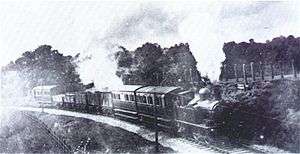GWR 517 Class
|
GWR 517 Class on a mixed train, 19th century | |||||||||||||||||||||||||||||||||||||||||||||||||
| |||||||||||||||||||||||||||||||||||||||||||||||||
| |||||||||||||||||||||||||||||||||||||||||||||||||
| |||||||||||||||||||||||||||||||||||||||||||||||||
| |||||||||||||||||||||||||||||||||||||||||||||||||
The 517 Class were small 0-4-2T tank engines designed by George Armstrong for local passenger work on the Great Western Railway.[1] They were built at Wolverhampton Works and were outshopped between 1868 and 1885. They were built in thirteen lots commencing with 517–528 and ending with 1477–1488 in 1884–1885.
Dimensions
The class was far from uniform and encompassed three different wheelbases, saddle and side tanks, and various boilers to name just a few variations. Driving wheels were 5 ft 0 in (1.524 m) (later 5 ft 2 in or 1.575 m due to thicker tyres), cylinders 15 in × 24 in (381 mm × 610 mm), (later 16 in × 24 in or 406 mm × 610 mm) and boiler pressure 150 psi (1.03 MPa) (later 165 psi or 1.14 MPa).
Summary table
| Year | Lot | Quantity | GWR No. | Notes |
|---|---|---|---|---|
| 1868 | D | 10 | 517–528 | 13 ft 7 in (4.14 m) wheelbase |
| 1868–69 | E | 12 | 529–540 | |
| 1869 | F | 12 | 541–552 | |
| 1869 | G | 12 | 553–564 | |
| 1869–70 | H | 12 | 565–576 | |
| I | 12 | 1421–1432 | 15 ft 0 in (4.57 m) wheelbase | |
| 1873–74 | R | 12 | 826–837 | |
| 1874–75 | S | 12 | 838–849 | |
| 1875–76 | W | 12 | 1154–1165 | |
| 1876 | Z | 13 | 202–205, 215–222 | |
| 1877–78 | C2 | 12 | 1433–1444 | |
| 1883 | M3 | 12 | 1465–1476 | 15 ft 0 in (4.57 m) wheelbase |
| 1884–85 | P2 | 6 | 1477–1482 | |
| 1884–85 | P2 | 6 | 1483–1488 | |
History
The earlier ones were rebuilt from saddle tanks while the later ones were built as side tanks from the beginning. The 3571 Class were very closely related, its prototype being a minor rebuild of 517 class No. 1477 in 1895. Then ten new locos followed in the next two years. Returning to the 517 class, various bunker and cab combinations also evolved, and after their last rebuilding, the locos with enclosed cabs and large bunkers were effectively the progenitors of Collett's 4800 class. In 1898 No. 1473 was named Fair Rosamund, to work a royal train on the Oxford-Woodstock branch. The engine was the usual one for the Woodstock branch in subsequent years.
The Armstrong brothers
The independence of the brothers Armstrong is aptly symbolised by the fact that Joseph at Swindon preferred the 2-4-0T wheel arrangement (the 455 Class "Metro" Tanks) to the 0-4-2; George, on the other hand, built no 2-4-0Ts at Wolverhampton.
Use
In the 19th century the 517s were principally Northern Division engines, and when new worked the Birmingham and Wolverhampton suburban traffic. Under Churchward the situation changed: about half of the class was fitted for autotrain working, and these engines were regularly maintained and moved around the system where needed; while the other, unconverted engines were demoted and became little more than shunters. Nevertheless as late as the 1920s the class was found in almost all parts of the GWR system. Most of the class ran between a million and a million and a half miles (2,400,000 km), No. 1163 holding the record at 1,652,661. None of the 517s was preserved, the last survivor No. 848 being scrapped in 1945 when aged 70.[2]
Accidents and incidents
- On 15 April 1923, locomotive No. 215 was hauling Autocoach No. 70 when it was in a head-on collision with a freight train at Curry Rivel, Somerset due to a signalman's error. Nine people were injured.[3]
Notes
- ↑ Holcroft 1971, pp. 34–35.
- ↑ Tabor 1959, p. F9-F20.
- ↑ Vaughan & 1989 pp-29-32.
References
- Casserley, H. C. & Johnston, Stuart W. (1966). Locomotives at the Grouping 4: Great Western Railway. Shepperton, Middlesex: Ian Allan Limited. pp. 20–21.
- Whitehurst, Brian (1973). Great Western engines, names, numbers, types, classes: 1940 to preservation. Oxford: Oxford Publishing Company. pp. 16, 17, 102, 125. ISBN 0-902888-21-8. OCLC 815661.
- Holcroft, Harold (1971) [1957]. An Outline of Great Western Locomotive Practice 1837-1947. Shepperton: Ian Allan. ISBN 0-7110-0228-2.
- Tabor, F.J. (1959). The Locomotives of the Great Western Railway, part six: Four-coupled Tank Engines. RCTS.
- Vaughan, Adrian (1989). Obstruction Danger. Wellingborough: Patrick Stephens Limited. ISBN 1-85260-055-1.
